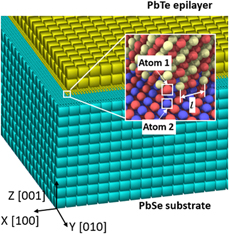Crossref Citations
This article has been cited by the following publications. This list is generated based on data provided by
Crossref.
Chen, Youping
Shabanov, Sergei
and
McDowell, David L.
2019.
Concurrent atomistic-continuum modeling of crystalline materials.
Journal of Applied Physics,
Vol. 126,
Issue. 10,
Xu, Shuozhi
Li, Yang
and
Chen, Youping
2020.
Si/Ge (111) Semicoherent Interfaces: Responses to an In‐Plane Shear and Interactions with Lattice Dislocations.
physica status solidi (b),
Vol. 257,
Issue. 12,
Selimov, Alex
Xu, Shuozhi
Chen, Youping
and
McDowell, David
2021.
Lattice dislocation induced misfit dislocation evolution in semi-coherent {111} bimetal interfaces.
Journal of Materials Research,
Vol. 36,
Issue. 13,
p.
2763.
Radhi, Ali
Iacobellis, Vincent
and
Behdinan, Kamran
2021.
Unraveling a thermodynamic ensemble at the quasicontinuum scale: Interplay of van der Waals forces without all the atoms.
Journal of Physics and Chemistry of Solids,
Vol. 153,
Issue. ,
p.
110026.
Davis, Alexander S.
Lloyd, Jeffrey T.
and
Agrawal, Vinamra
2022.
Moving window techniques to model shock wave propagation using the concurrent atomistic–continuum method.
Computer Methods in Applied Mechanics and Engineering,
Vol. 389,
Issue. ,
p.
114360.
Diaz, Adrian
Gu, Boyang
Li, Yang
Plimpton, Steven J.
McDowell, David L.
and
Chen, Youping
2022.
A parallel algorithm for the concurrent atomistic-continuum methodology.
Journal of Computational Physics,
Vol. 463,
Issue. ,
p.
111140.
Shirvani, Fatemeh
and
Shokri, Aliasghar
2023.
Electrical and optical properties of PbSe/PbTe heterostructures containing vacancies, doping, and alloys using first-principle calculations.
The European Physical Journal Plus,
Vol. 138,
Issue. 3,
Li, Yang
Zheng, Zexi
Chen, Xiang
and
Chen, Youping
2023.
Dynamic interaction between phonons and edge dislocations in LiF.
Journal of Applied Physics,
Vol. 134,
Issue. 19,
Sun, Jiaqi
Taormina, Nicholas
Bilgili, Emir
Li, Yang
and
Chen, Youping
2024.
Bridging length and time scales in predictive simulations of thermo-mechanical processes.
Modelling and Simulation in Materials Science and Engineering,
Vol. 32,
Issue. 8,
p.
085015.
Taormina, Nicholas
Li, Yang
Phillpot, Simon
and
Chen, Youping
2024.
Effects of misfit dislocations and dislocation mobility on thermal boundary resistance of PbTe/PbSe interfaces.
Computational Materials Science,
Vol. 235,
Issue. ,
p.
112828.
Gu, Boyang
Li, Yang
Diaz, Adrian
Peng, Yipeng
McDowell, David L.
and
Chen, Youping
2025.
Brittle and ductile deformations in uniaxial compression of Si micropillars.
Acta Materialia,
Vol. 291,
Issue. ,
p.
121007.
